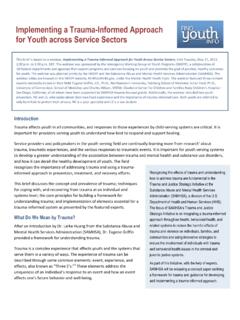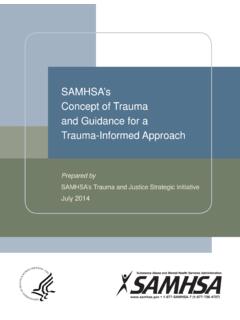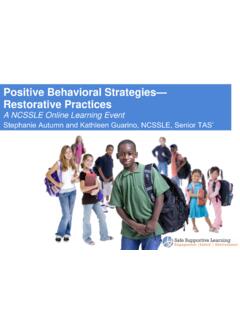Transcription of Trauma-Informed Care
1 Congregate Care in the Age of Family First: Trauma-Informed Care1 Trauma-Informed CareThere is broad recognition that children and youth engaged with the child welfare system experience exposure to trauma at significant rates. For youth in foster care, rates of trauma exposure approach 90 percent (Dorsey et al., 2012). Acute trauma can result from a single event, while complex trauma can result from exposure to multiple, pervasive, interpersonal traumatic events such as ongoing maltreatment. While trauma and toxic stress can lead to lifelong health impacts, emerging research indicates that trauma -exposed children and youth can heal and even thrive after Trauma-Informed treatment (Fuller-Thomson et al., 2020; Yoon et al., 2019).This resource can help child welfare agency leaders and managers, residential treatment programs, and other organizations understand the Trauma-Informed care requirements of the Family First Prevention Services Act (FFPSA) and thoughtfully plan for a Trauma-Informed approach to residential the LawThe FFPSA requires Trauma-Informed practice along the full continuum of child welfare services.
2 Eligible services and programs must be provided under an organizational structure and treatment framework that involves understanding, recognizing, and responding to the effects of all types of trauma and in accordance with recognized principles of a Trauma-Informed approach and trauma -specific interventions to address trauma s consequences and facilitate healing (Children s Bureau, 2018).Residential programs approved as Qualified Residential Treatment Programs (QRTPs) must use an appropriately staffed Trauma-Informed treatment model that meets the behavioral health care needs of child and youth residents (Children s Bureau, 2018). Upon admission to a QRTP, a functional assessment must be completed by a Qualified Individual who is neither employed by the title IV-E agency nor affiliated with any QRTP, although there are options for states to request a waiver of these requirements (Children s Bureau, 2018).
3 The functional assessment must indicate the QRTP is the most appropriate setting for reimbursement to continue past the 14th day of care (Children's Bureau, 2018).Read this if:You are interested in learning more about steps states can take to ensure Trauma-Informed congregate care under the Family First Prevention Services Act (FFPSA).Learn more about: uImplementing FFPSA requirements uPrioritizing Trauma-Informed care in residential treatment uCentering equity in implementation uExploring potential considerations and next steps for planningCongregate Care in the Age of Family First: Trauma-Informed Care2 Adverse Childhood ExperiencesA landmark study in the 1990s established a link between early childhood experiences and adult health outcomes. The Adverse Childhood Experiences (ACE) Study found that childhood exposure to traumatic or adverse experiences contributed to adult physical and behavioral health conditions.
4 Multiple adverse experiences were associated with the most severe health implications (Centers for Disease Control and Prevention, ).The original survey asked adults about exposure to the most prevalent and well-researched traumatic childhood experiences, including abuse, neglect, household mental illness and domestic violence, and loss of a parent due to death, incarceration, or divorce. As communities and states begin to administer local questionnaires, some have added questions about exposure to other types of ACEs, such as community violence, racism, and bullying (Philadelphia ACE Project, 2020; State of California Department of Health Care Services, 2020). Other efforts have focused on building protective factors to buffer adversity and support resilience (Child Welfare Information Gateway, 2020).More information can be found at Child Welfare Information Gateway: Adverse Childhood Experiences (ACEs).
5 Core Principles of Trauma-Informed CareOver the past few decades, professional understanding of trauma and its causes has expanded to include the traumatic impact of maltreatment on children and youth . As the understanding of trauma deepened, treatment approaches began to move away from addressing behavioral symptoms and toward addressing the root causes of those behaviors. As a result, professionals working with youth began asking What happened to you? instead of What s wrong with you? ( Trauma-Informed Care Implementation Resource Center, 2019). While a Trauma-Informed approach to individual clinical practice is critical, it must exist within an organizational commitment to Trauma-Informed care. Residential settings that treat children and youth with exposure to trauma must ensure that practice is rooted in the following principles ( Trauma-Informed Care Implementation Resource Center, 2019).
6 USafety: Children and youth feel both psychologically and physically safe in their environment and during interactions. uTrustworthiness and transparency: Trust is an explicit organizational goal. Families and youth are engaged in partnership and included in decisions. Expectations and accountability are clear to youth , families, staff, and leadership. uPeer support: Opportunities for peer support are available for youth and for families, including siblings, and are considered essential practice. uCollaboration: youth and families are empowered to share in decision-making and are viewed as experts in their own experiences. uEmpowerment: Staff at every level of the organization believe that youth are capable and able to heal from trauma . youth and family strengths are celebrated and validated. Resilience is clearly defined. youth are provided with the support necessary to make and learn from mistakes.
7 UHumility and responsiveness: Staff receive training in historical trauma . There are opportunities to reflect on and address implicit bias. Cultural and racial humility and responsiveness are organizational expectations and are reflected in policies and practices. Congregate Care in the Age of Family First: Trauma-Informed Care3 Centering Equity in Trauma-Informed CareHistorical trauma impacts generations of people following significant traumatic events such as enslavement or genocide. While many members of a population may not experience effects from historical trauma , for others it may contribute to poor physical and mental health outcomes or distrust of majority groups and government services (Administration for Children and Families et al., 2017). For children and youth of color in the child welfare system, historical trauma and exposure to racism can compound the toxic stress of maltreatment (Administration for Children and Families et al.)
8 , 2017; Child Welfare Committee, National Child Traumatic Stress Network & Chapin Hall, 2020).During service delivery, child welfare professionals should be mindful of historical trauma and its potential impact on children, youth , and families. In addition, agencies can foster organizational environments that promote cultural humility, an ongoing process that emphasizes self-reflection and a willingness to learn from others (National Child Welfare Workforce Institute, 2017; Ortega & Coulborn, 2011).Agency leaders can consider the following questions as they work to center equity in Trauma-Informed care: uDo leaders and staff understand the impact of historical trauma on behavioral health? uIs equity reflected in the organization s mission, vision, values, and policies? uDoes the organization support cultural humility and do practices reflect it? uAre youth and families from populations served involved in the development and implementation of programs, policies, and training?
9 Considerations for Residential Trauma-Informed CareAssessment and AdmissionWithin 30 days of admission to a QRTP, a functional assessment must be completed by a skilled, well-trained clinician designated as a Qualified Individual. Qualified Individuals should understand trauma and appropriate treatment modalities and be comfortable talking about trauma and handling disclosures assessment process should include gathering information from the child or youth , their families, and other important people in their life. A deeper understanding of the child s or youth s exposure to traumatic events can inform the most appropriate type of treatment setting. If the assessment indicates a need for residential treatment, the child or youth must have access to a Trauma-Informed treatment program that is appropriate to meet their identified needs. Trauma-Informed TreatmentQRTPs must use Trauma-Informed treatment models that meet the behavioral health care needs of the children and youth in care and must be staffed by skilled clinicians with a deep understanding of trauma and its impact.
10 Clinicians should be well trained in the model(s), with access to ongoing professional development and coaching for fidelity, as well as clinical supervision rooted in an understanding of secondary trauma and , including siblings, should be involved in treatment as appropriate. Families and youth should have clinical support to prepare for and debrief family visits. In preparation for discharge, families should have an opportunity to learn and practice skills that can be applied in the home setting and should be connected to community-based services and supports. Following discharge, families should receive a minimum of 6 months Trauma-Informed aftercare to support a stable transition OrganizationsThe delivery of trauma treatment is critical but insufficient without organizational models and cultures that are informed by trauma experienced by both youth and staff (Child Welfare Committee, National Child Traumatic Stress Network & Chapin Hall, 2020).





